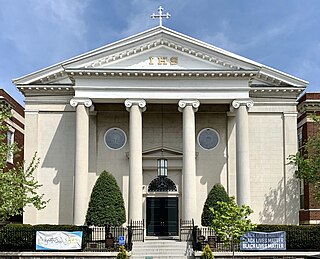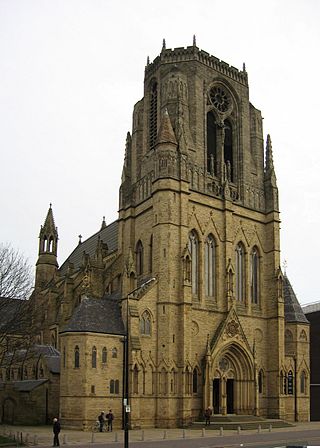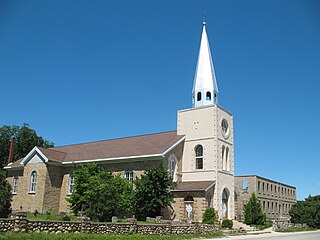
The University of the Witwatersrand, Johannesburg, is a multi-campus South African public research university situated in the northern areas of central Johannesburg. It is more commonly known as Wits University or Wits. The university has its roots in the mining industry, as do Johannesburg and the Witwatersrand in general. Founded in 1896 as the South African School of Mines in Kimberley, it is the third oldest South African university in continuous operation.

Melville is a bohemian suburb of Johannesburg, Gauteng, South Africa. It is the location of many restaurants and taverns, which are mostly frequented by students from the nearby University of Johannesburg, located in Auckland Park, and the University of the Witwatersrand, located in Braamfontein. It is one of the city's most popular tourist destinations. The suburb is to the west of the Johannesburg CBD. It is located in Region B of the City of Johannesburg Metropolitan Municipality.

The Catholic Church in South Africa is part of the worldwide Catholic Church composed of the Latin Church and 23 Eastern Catholic Churches, of which the South African church is under the spiritual leadership of the Southern African Catholic Bishops Conference and the Pope in Rome. It is made up of 26 dioceses and archdioceses plus an apostolic vicariate.

The Diocese of Cleveland is a Latin Church ecclesiastical territory or diocese of the Catholic Church in the northeastern portion of the U.S. state of Ohio. Pope Pius IX erected the diocese April 23, 1847, in territory taken from the Archdiocese of Cincinnati. The diocese lost territory in 1910 when Pope Pius X erected the Diocese of Toledo, and in 1943 when Pope Pius XII erected the Diocese of Youngstown. It is currently the 17th-largest diocese in the United States by population, encompassing the counties of Ashland, Cuyahoga, Geauga, Lake, Lorain, Medina, Summit, and Wayne. As of September 2020, the current bishop is Edward Charles Malesic. The Cathedral of St. John the Evangelist located in downtown Cleveland is the mother church of the diocese.
St. Mary of the Assumption Parish in Bridgeton, Missouri was a Catholic parish in northwestern St. Louis County, located within the Archdiocese of St. Louis. Founded in 1851, the parish population expanded with suburban development at such a rate in the 1950s and 1960s that seven new parishes were created in the area. This parish was closed in 2001 due to planned expansion of St. Louis Lambert Airport. The parish church and related buildings were acquired by the airport and razed in 2004.

Holy Trinity Catholic Church is a Catholic church run by the Jesuit order that is located in the Georgetown neighborhood of Washington, D.C., in the United States. Holy Trinity Parish was founded in 1787 and is the oldest Roman Catholic community and house of worship in continuous operation both in Georgetown and in the larger city of Washington, D.C. The original church building was completed in 1794. It is now called the Chapel of St. Ignatius, and is used for smaller ecclesiastical celebrations and as an auxiliary space for parish activities. A larger church building, necessitated by the growing community, was dedicated in 1851, and still serves as the parish church today.

Francis Ignatius Neale, also known as Francis Xavier Neale, was an American Catholic priest and Jesuit who led several academic and religious institutions in Washington, D.C., and Maryland. He played a substantial role in the Jesuit order's resurgence in the United States.

The Church of the Holy Name of Jesus on Oxford Road, Manchester, England was designed by Joseph A. Hansom and built between 1869 and 1871. The tower, designed by Adrian Gilbert Scott, was erected in 1928 in memory of Fr Bernard Vaughan, SJ. The church has been Grade I listed on the National Heritage List for England since 1989, having previously been Grade II* listed since 1963.
Wits University Football Club, also known as Wits FC, is the football club representing the University of the Witwatersrand based in Johannesburg, South Africa.

The Parish of the Holy Sacrifice, also known as the Church of the Holy Sacrifice, is a landmark Catholic chapel on the University of the Philippines Diliman campus. It belongs to the Roman Catholic Diocese of Cubao and its present parish priest is Rev. Fr. Jose S. Tupino III. More popularly known as the UP Chapel, the church was constructed under the supervision of Fr. John P. Delaney, who began ministering to the spiritual needs of the campus in 1947.
Franz Pfanner, also anglicised as Francis Pfanner, was an Austrian Trappist abbot and founder of Mariannhill Monastery in South Africa and the Mariastern Abbey in Banja Luka, Bosnia and Herzegovina.

The Mariannhillers, officially named the Congregation of the Missionaries of Mariannhill are a religious institute of the Catholic Church founded by Dom Franz Pfanner. They were originally a monastery of Trappist monks founded in 1882 by Pfanner, but were later branched off as a separate congregation by decree of the Holy See. The name of the congregation comes from Mariannhill, a suburb near Pinetown in KwaZulu Natal, South Africa, where the congregation was first established.

Regina Mundi, designed by architect Anthony Noel Errol Slaven, is the largest Roman Catholic church in South Africa. It is located in Rockville, Soweto, a populous black urban residential area within the city of Johannesburg. Due to the role it played as a place of gathering for the people of Soweto in the years before, during, and after the anti-apartheid struggle, it is often referred to as "the people's church" or "the people's cathedral".

The Church of the Immaculate Conception, Farm Street, also known as Farm Street Church, is a Roman Catholic parish church run by the Society of Jesus in Mayfair, central London. Its main entrance is in Farm Street, though it can also be accessed from the adjacent Mount Street Gardens. Sir Simon Jenkins, in his book England's Thousand Best Churches, describes the church as "Gothic Revival at its most sumptuous".

Holy Cross Church is a Roman Catholic Parish church in the Wiikwemkoong Unceded Reserve, north-eastern Manitoulin island. It was founded by the Society of Jesus (Jesuits) in 1844 and was their first mission in Northern Ontario since their suppression in 1767. The mission played a significant role in increasing literacy in Canada of the Ojibwe language. The church building itself was constructed in 1852. It is situated to the north of Wiikwemkoong on Wikwemikong Way, next to the Giizhigaanang Community Centre.

#FeesMustFall was a student-led protest movement that began in mid-October 2015 in South Africa. The goals of the movement were to stop increases in student fees as well as to increase government funding of universities. Protests started at the University of Witwatersrand and spread to the University of Cape Town and Rhodes University before rapidly spreading to other universities across the country. Although initially enjoying significant public support the protest movement started to lose public sympathy when the protests started turning violent.

Stephen Larigaudelle Dubuisson was a French Catholic priest and Jesuit missionary to the United States. Born to a wealthy family in Saint-Domingue, Dubuisson fled the Haitian Revolution for France, where he entered the civil service and rose to senior positions in Napoleon's imperial court. In 1815, he decided to enter the Society of Jesus and sailed for the United States. He engaged in pastoral work in Maryland and Washington, D.C., before becoming the president of Georgetown College in 1825. An austere personality, his leadership of the school was not successful. He suffered a nervous breakdown and was sent to recover in Rome in 1826, where he met Jan Roothaan, the Jesuit Superior General. Upon returning to the United States, he acted as a close confidant of Roothaan.

Arthur Aloysius O'Leary was an American Catholic priest and Jesuit, who served as president of Georgetown University in from 1935 to 1942. Born in Washington, D.C., he studied at Gonzaga College before entering the Society of Jesus and continuing his education at St. Andrew-on-Hudson and Woodstock College. He then taught at St. Andrew-on-Hudson and Georgetown University, where he eventually became the university's librarian, and undertook a major improvement of the Georgetown University Library. O'Leary then assumed the presidency of the university in the midst of the Great Depression and, later, World War II.















